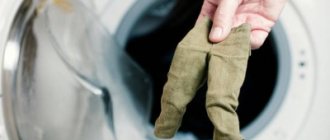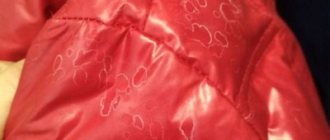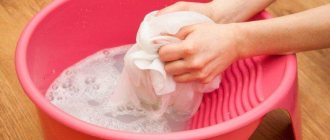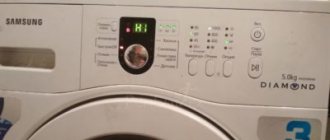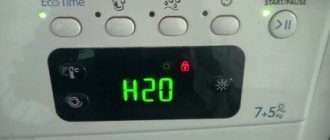Washing is necessary to return contaminated items to their former “marketable” appearance. And the problem with laundry getting dirty by a washing machine is familiar to many. It is very unpleasant to throw dirty things into the drum and take out stained ones.
There are quite a few reasons why an automatic machine gets things dirty, and the things you take out can have a wide variety of degrees of soiling:
- The spots may be rusty, yellow, brown, orange;
- Oily, black, grayish;
- White items may turn yellow or grey;
- Less bright products acquire the color of brighter ones;
- Etc.
As the practice of most reputable workshops shows, in 80% of cases the cause of dirty things is not the automatic machine (of course, provided that the rules for its operation are followed).
Therefore, let's look at these reasons and determine methods to combat them.
Why might stains appear after washing?
The actions that will help get rid of them depend on the accuracy of determining the origin of the stains. The most difficult case is when several types of marks are combined at once. In this case, a whole range of measures will be required to solve the problem. However, some actions recommended on the Internet are simply dangerous for clothes! And if you follow the advice of an unknown well-wisher, you can ruin an expensive and beloved thing.
Rice. 2 — Washing clothes in a machine
White spots
Typically, the cause of these marks is bleach. If you use it incorrectly or buy a low-quality one, white marks remain. If the fabric is burned by the bleach, the item will have to be thrown away. However, if the bleach is of high quality, the wrong dosage was simply used, the traces can be removed. To do this, you need to rinse the item thoroughly in cold water, or in a washing machine.
But what if the fabric is burned out and it can no longer be removed, but you want to save the thing? In this case, there is only one way out - painting the thing. Some people recommend painting over the white areas with a permanent marker or rubbing alcohol on an undamaged area of the fabric to dissolve the paint, and then using the same cotton pad to rub the white mark. From this procedure, it should be partially painted with paint removed from the whole area. However, neither one nor the other method is suitable for clothes that need to be worn, for example, to work, because it will be visible that the item is poorly dyed. The best solution is to take it to a dry cleaner for painting or paint it completely at home by purchasing a product specially designed for this.
Yellow spots
They are left on clothes by a product to protect the machine from scale. They also remain after some types of powder (however, powdered products often leave blue marks). Yellow marks from the powder occur if, when reacting with water, the product turns yellow and then stains things.
Also, occasionally the composition of water causes such a problem. In some areas, the water is very hard, with a lot of impurities. And they, settling on clothes, leave yellow marks. These can be both large areas and small points.
Dark spots
Light marks are not visible on every item, unlike, for example, black and brown ones. They will cause the greatest horror to the owner of the dress, since they are the most difficult to remove and can remain noticeable for a long time.
What are the reasons why stains appear on clothes after washing in a machine?
- washing machine breakdowns;
- dirt on the rubber rim;
- mold in the unit.
Rice. 3 – Mold in the washing machine
Failures can also be different, for example, problems with a bearing, clogged drain hose or filter. How to distinguish them? If the hose or filter is clogged, small marks will appear, and if there are problems with the bearing, streaks will appear.
Rust stains
Rust stains can appear for a variety of reasons, and in order to get rid of the problem, it is important to find out what the exact reason is in your particular case. They can be called:
They can appear for various reasons
And in order to get rid of the problem, it is important to find out what exactly the reason is in your particular case
They can appear for various reasons
And in order to get rid of the problem, it is important to find out what exactly the reason is in your particular case
They can be called:
- insufficiently rinsed laundry with washing powder residues;
- water with too high levels of iron;
- low quality metal fittings on things.
The difficulties are that it is not easy to distinguish one reason from another, or they can be combined. If the unfiltered water that comes out of your tap has an orange color or a rusty taste, then there is most likely a problem with the water. In this case, a filter is installed on the washing machine. It is inexpensive and will save a lot of good
And if you know that there is poor water pressure in the pipes in your home, we can conclude that the powder is not washed out well. Weak water pressure can also be seen from the fact that the drum of the machine is not filled with enough water, and things float in a very small amount of it. Poorly diluted powder can cause not only red spots, but also blue ones. However, the cause of blue marks is usually easy to diagnose, since they almost always appear from the powder.
If stains remain from fittings (clasps, pendants), then they will most likely be bright, distinct, and will begin to appear in those places where the fabric came into contact with these fittings.
Loading …
The cuff is dirty or there are problems with the seal
Mold in the middle of the washing machine is just a small thing. The reason why a housewife gets her things dirty may also lie in other problems. So, if the washing machine has been improperly cared for (or not cared for at all) throughout the year, a thick layer of gray dirt will accumulate on the cuff and under it. After washing, it will appear as small gray spots on things.
What to do with such a problem? You just need to take a medium-hard brush (a toothbrush will do), a rag, and start cleaning the cuff of all this “good.” Plaque must be removed wherever possible - from every crack. The main thing is not to overdo it and not harm the cuff.
If after washing you take out items with oil or fuel oil stains, then the problem in 90% of cases lies in the seal. The thing is that when the seals wear out, they begin to throw oil into the water tank, which then ends up on clothes.
In such a situation, you need to act extremely quickly, since when they “die,” the seals will not only stain the fabric, but will also constantly take on a large flow of water. This will lead to corrosion and the bearings will very quickly become unusable.
It may be that you are too late and the bearings have already broken. They will “give” themselves away by creaking and grinding during washing. As in the first and second situations, urgent replacement of oil seals and bearings is necessary.
This procedure is quite complicated and it is best to entrust it to professional craftsmen. Of course, you can try it yourself, but then you will have to do the following:
- Completely disassemble the machine;
- Make a cut using a grinder and remove the tank;
- Carefully remove the failed bearings and install new ones.
Using too little or too much detergent
In fact, knowing how much detergent to use is quite simple, since the packaging contains all the required information regarding how much to put in and how to use it correctly. The amount largely depends on how much laundry you wash.
It is also important to consider how hard the water is. If the water has a high lime content, then it is considered hard and therefore you need to use a little more detergent
Unpleasant odors may appear if only liquid detergents are used when washing. Unlike powder or capsules, they do not contain bleach, which helps kill germs. The disadvantage of bleaching agents is that they can only be used on light-colored clothing.
If using the required amount of powder or detergent does not give any result, then you can try hygiene products. They contain disinfectants that help eliminate germs from the washing machine that cause an unpleasant odor. However, it is not recommended to use it every time you wash.
Women's jeans: before you buy them, you need to pay attention to one detail
Smooth and fresh skin: dermaplaning, or why a woman needs to shave her face
A student at the Vietnam Police Academy shared how she takes care of her facial skin.
Recommendations and videos
Avoiding stains after washing is easy. This requires:
- Follow the washing rules. Sort laundry by fabric, color and type of stain. Stick to the powder dosage.
- Do not use a faulty washing machine. Monitor the condition of seals and bearings.
- Care for SMA in accordance with the recommendations in the instructions.
- Check pockets for contents before washing.
- Wash items with metal parts only in special bags.
If you follow preventive measures, tips and recommendations, it is easy to avoid the appearance of new dark spots on things after washing. If trouble does happen, getting rid of them is not as difficult as it seems.
Why does the washing machine tear clothes?
Whatever the SMA - cheap or expensive, compact or full-sized, multifunctional or with a limited list of options, it should not spoil the laundry, much less tear it.
If, when washing, things tear and burst at the seams, then you are faced with a malfunction. Your task is to determine why it arose in order to subsequently eliminate it correctly.
The reasons why clothes tear badly during washing may be the following:
- Things tear themselves apart with sharp elements.
- There is minor damage inside the drum, which causes damage to your items.
- In vertical SMA, clothes can deteriorate by clinging to protruding elements: chipped plastic, springs, etc.
- Damage to laundry can occur due to a loose drum.
- Often, rips in clothing are caused by aggressive washing cycles that weaken the fabric.
If the problem is not in the washing machine
It’s a shame when things are dirty after washing instead of becoming clean. There can be many reasons for the problem
It is important to identify and eliminate them, otherwise the situation will not only repeat itself, but also get worse.
Stains on clothes
After all, what's the point of washing if it results in new stains? More details:
Poor quality laundry detergent. If the powder particles do not completely dissolve in water, then as a result of the process not only white stains appear on the laundry, but also colored spots matching the color of the active granules. However, it is not always possible to call the powder low-quality. This may be due to insufficient rinsing, excess use of the product, water hardness and other factors. Ideally, it is better to find a product that suits you in all respects - quality, price and results - and continue to use it all the time.
Water high in minerals. Especially iron, which penetrates the fabric fibers and oxidizes when dried. As a result, yellow or red stains appear on things after drying. The problem is solved by purchasing a special filter. An easier way is to drain the water from the tap before using the washing machine.
Violation of washing rules. Often the reason why good things fall into disrepair. Do not neglect one of the most important rules - white and colored items must be washed separately. Fortunately, in most cases the problem is solved by restarting the cycle using detergents individually for the affected clothing. If this event does not help, you will most likely have to rejoice in the new color.
Foreign object in drum
It doesn't matter how he got there. But the result is visible, as they say, “obviously” or on your favorite shirt
It will need to be found and removed. Then wash the soiled items again.
Soaking items covered in grease with the rest. Of course, this should not be done, since during the washing process the clothes come into contact with each other. As a result, yellowish-oily spots appear. “Greasy” items should be washed separately from the rest.
Grease stains on a down jacket
If your jacket or down jacket is damaged due to one of the above factors, do not be upset. After eliminating the source of the stains, you need to wash the product again. Among the most common types of contamination, it is necessary to note white stains from washing powder or greasy stains.
For greasy or oily stains, a dishwashing detergent with a grease-dissolving effect will help. It is necessary to treat contaminated areas with gel and leave the product in this form for 30-40 minutes. Then, without rinsing, soak in water at a temperature of 30-40 degrees for 2-3 hours, so that the molecules of the product penetrate into all the fibers where fat could get. Then do the washing.
Washing machine operating mode
Regardless of whether the machine is modern or not, expensive or not, an incorrectly selected mode may not bring the desired result, even leading to failure of the unit.
Any model, regardless of the brand of the machine, has standard washing modes. There may be slight differences in the list of additional functions, names or images, but the essence of such programs is the same.
The most popular washing modes:
- Cotton is one of the most common modes used for cotton fabrics such as bedding or cotton clothing. The spin is performed at maximum speed, and the washing temperature can reach up to 95 degrees. When washing items with patterns, the temperature decreases. The speed can also be reduced if necessary;
- Synthetics – used when washing non-natural fabrics. For example, polyester and polyamide blouses and shirts, products made from fabrics of a similar composition. This mode has less heating than for cotton - from 40 to 60 degrees (depending on the model of the washing machine);
- Wool – a mode for gentle cleaning of woolen items.
To avoid changes in shape and shrinkage of the product, low temperatures (up to 40 degrees) and low speeds are used. To achieve gentle washing, two to three times fewer items are loaded into the drum than usual. Woolen items are washed by gently rocking them in a drum filled with water; - Children's clothing - since children's clothes are usually very dirty, this mode uses a high-temperature wash. The extra rinse prevents the possibility of detergent remaining in the machine. If the model does not have this mode, but you need to wash children’s clothes, then use the “Cotton” mode with an additional rinse at the end;
- Quick wash - sometimes this mode is called “Eco mode”, “Express wash”, “Daily wash”, “Manual mode” and others.
The program provides for the use of water no higher than 30 degrees, so clothes that are not heavily soiled are washed this way. This is not washing, but rather refreshing clothes, since the drum rotates slowly, which ensures a delicate effect on the fabric. There is no spin, and the cycle takes half an hour; - Delicate - differs from quick wash in that washing occurs at high temperatures. This mode can be used when washing not only delicate items, but also wardrobe decorative elements;
- Intensive – a powerful mode for cleaning soiled items made from durable fabrics. Can apply temperatures up to 90 degrees;
- Soaking or pre-washing is the longest mode, combining two operations. It is used when you need to pre-wash things in an intensive powder containing a stain remover, and then dry them. This product is poured into the third compartment of the powder container.
In order for the user to independently select exactly the mode he needs, manufacturers have included additional functions in washing machines. With their help, you can adjust the wash, expanding the functionality.
Common additional features:
- Additional rinsing – allows you to rinse your laundry better, especially useful when there is too much powder, and also to prevent an allergic reaction to the composition of the washing powder;
- Partial loading is useful when there are not many items to wash. A half load will go through all the normal wash cycles, but faster;
- Without spin - used if the machine does not have a program in which there is no spin. In this case, the option is set additionally. It is also used for things that can be damaged by the impact of the drum;
- Ironing – when the ironing function is turned on, the machine skips the intermediate spin cycle and rinses items with a high water content;
- Water level control - found mainly among washing machines above the middle class. Its meaning is that the machine independently weighs the laundry loaded into the drum and adds the amount of water necessary for high-quality washing, which is very economical.
It is recommended to follow certain rules when using the washing machine:
- Before loading things into the tank, they need to be sorted by fabric type and color;
- Be sure to check the pockets on things and remove foreign objects from them;
- Terry and knitted items must be turned inside out so that other items will not be spoiled by small particles rolling off their surface;
- Strictly follow the machine manufacturer's recommendations for loading;
- Pour detergents strictly into the designated compartments of the container.
DIY repair
The user can eliminate defects not related to the technical condition with his own hands.
- Set the correct program to suit your clothing.
- Choose a good detergent (recommended by the manufacturer or time-tested).
- Soften the water to prevent failure of the heating element.
- Pre-soak fabric with stubborn stains or wash them with laundry soap.
- In rare cases, the user can independently replace the bearings or belt (if there is an understanding of the design of the device).
In all other cases, you must contact the service.
Instructions
Baking soda is an affordable, natural, and versatile solution for removing stains from fabrics, making them soft, and refreshing the colors of items.
1 answer and comment
Ammonia is a universal cleaner for all types of fabrics, carpets, fur, leather, suede products.
replies and comments
Vinegar is an effective, natural, and versatile fabric cleaner and stain remover.
replies and comments
Gasoline is a cleaning agent against stains on clothes and skin.
replies and comments
Lemon juice is a universal cleaner that can cope with any dirt and unpleasant odors.
2 replies and comments
Boric acid is an effective and affordable means for bleaching and cleaning fabrics, including wool and silk.
3 replies and comments
Hydrogen peroxide is an indispensable cleaning agent for white fabrics, fur, suede, and wool.
replies and comments
Salt is a universal, harmless remedy for removing any dirt from fabrics, as well as making them soft and refreshing colors.
replies and comments
Mustard is a natural, safe remedy for removing various stains from fabrics, including delicate ones.
replies and comments
Toothpaste: More than just for brushing your teeth, it's an all-purpose cleaner for so many things
replies and comments
Vegetable oil: non-standard uses - from removing chewing gum to washing and bleaching kitchen towels and linen
replies and comments
Acetone – effective removal of grease stains and stains of unknown origin
replies and comments
Starch is an affordable natural remedy for removing stains from fabrics, tidying clothes and shoes, and eliminating unpleasant odors.
replies and comments
Laundry soap is a natural, affordable and highly effective means for washing clothes, bleaching fabrics and removing many types of stains
replies and comments
Solvents are indispensable cleaning agents for white and colored fabrics, fur, silk, wool.
replies and comments
Whitening and removing stains by boiling is an affordable and effective way to remove stains
replies and comments
Milk: delicate, gentle removal of difficult stains from colored and white natural fabrics
replies and comments
Alcohol as a cleaning, antimicrobial and antifungal agent
replies and comments
Cigarette ash - as a cleaning, absorbent and polishing agent
replies and comments
Aspirin as a stain remover: effective savings, removal of stains and odors
replies and comments
Cosmetic scrub as a cleaning agent - when and how it can be used to clean fabrics and other products
replies and comments
Crushed eggshells – as a natural bleach and cleaner
replies and comments
Kefir as a cleaning agent: an original, simple and inexpensive way to get rid of stains
replies and comments
Castor oil - as a household cleaner for fabric and leather products
replies and comments
Vaseline – medical and cosmetic, as a means for dissolving contaminants, caring for leather and wood products
replies and comments
Dishwashing detergent for removing greasy stains on clothes and furniture
replies and comments
How to remove stains
If you know how to remove stains, removing them after washing will not be a problem.
- Rust stains on linen can be removed with vinegar or lemon juice. The stain should be thoroughly wiped with this product and then rinsed with warm water.
- Ammonia effectively removes grease stains.
- Chalk and soap help remove grease and fuel oil stains from laundry. These substances are mixed, water is added, applied to the dirt and left for an hour, after which it is washed off.
What to do if your clothes start to smell bad?
When a faint, unpleasant odor emanates from washed items, it will be enough to hang the laundry in the fresh air.
It’s good if the day turns out to be windy and sunny. In this case, the laundry will quickly acquire the aroma of freshness. But you can’t dry it indoors - this will not help get rid of the stench, but on the contrary, it will strengthen it.
In case of a strong and persistent smell of rottenness (mold) from things, it is necessary to resort to rinsing in water with the addition of a scented rinse aid. After which prolonged drying in the fresh air is necessary.
Folk recipes
Sometimes rinsing and airing washed clothes is not enough to restore their freshness. Then it is recommended to use some effective folk remedies, which are presented in the table:
| Ingredients | Preparation | Application |
| Borax | Take 1.5 liters of warm water and dissolve 50 g of powder in it. | Soak the items in the resulting solution and place cling film on top of the container. Leave the items for 4 hours, then rinse and wash with regular powder. Dry outdoors. |
| Soda | It does not need to be dissolved in water and takes approximately 100 g. | Load smelly things into the drum. Washing powder is poured into one compartment, soda (about 100 g) into the other. Turn on the standard washing mode and at the end start rinsing 2-3 times. Then they dry the clothes in the fresh air. |
| Table vinegar (9%) | Dilute 170 ml of vinegar in 2.5 liters of water. Mix water with water in equal quantities. | Immerse the items in the solution for 1 hour and wash as usual. Pour liquid into the conditioner compartment and wash on a standard cycle. |
| Vodka | Used in its pure form. The ratio with water is 1:1. | Pour into a spray bottle and treat the foul-smelling item. It is advisable to carry out such manipulations on the street or balcony, hanging the products on a rope. |
| Alcohol | Combine alcohol and water in a 1:1 ratio. | |
| Ammonia | Dilute ammonia with water to obtain a slightly concentrated solution. | Things are sprayed with this product. The method is suitable for outerwear and hats. |
Chemicals
You can rehabilitate items after unsuccessful washing using special chemicals that effectively cope with unpleasant odors.
Thus, the Dr. Beckmann company produces various products for the care of things and fabrics, as well as household appliances. Their range of products includes some pretty effective odor eliminators.
Thanks to their unique formula, it is possible to destroy pathogenic bacteria from deep in the fibers. These products are used according to the instructions: added to washing powder or poured in instead of rinse aid.
Another option is Denkmit Hygienespüler. The product is suitable for all types of fabric. It is hypoallergenic, so it is recommended for use when washing even children's underwear. As a result, it helps to destroy fungi and bacteria in tissues by almost 100%, giving products freshness.
If 1 specific product stinks
Often, after washing, not all laundry smells, but individual items (for example, a terry towel or bathrobe). The washing machine is clearly not to blame here.
This phenomenon is usually observed due to an incorrectly selected detergent or washing mode. Therefore, you must first study the manufacturer’s recommendations on the product label.
Another reason for an item to smell bad is drying it in a closed room without good ventilation. As a result, the product does not dry completely, which leads to the formation of mold.
Therefore, it is better to dry terry products on a ventilated balcony or outside in the summer, and in winter - on a radiator or electric heated towel rail.
You can restore such a wonderful aroma by rinsing in a vinegar solution and drying it again in the fresh air.
How to eliminate yellowing of things
You can remove old stains from clothes using proven folk methods.
White laundry with stains is pre-soaked in water with the addition of alkaline soap. Apply a small amount of hydrogen peroxide to the yellow stains. The appearance of hissing means that the substance has begun to interact with the fibers of the fabric.
The product is kept for half an hour, after which it is rinsed and washed in the usual way.
The pharmaceutical drug Aspirin will help eliminate yellowish marks on your favorite white things. The clothes are soaked in a soap solution, 2 tablets of the product are placed in a glass, a few drops of water are added and until the tablets are completely dissolved. The resulting gruel is used to smear the spots. The product is kept for 2-3 hours, after which it is rinsed and placed in a washing machine.
A universal method for removing old marks is the use of soda with hydrogen peroxide.
To prepare the whitening composition, you will need:
- 20 g sodium bicarbonate;
- 1 bottle of peroxide;
- 5-10 g dishwasher detergent.
Rub the mixture into the stains with a brush and leave for several hours. After this, the laundry is washed and rinsed thoroughly.
You can buy dry alcohol in pharmacy chains. The white item is pre-soaked in laundry soap for 60 minutes. The fuel is diluted with a small amount of liquid and applied to the yellow spots for a while. The product can be washed in any convenient way.
Fairy
Regular Fairy dishwashing detergent will help you cope with stubborn yellow stains from sweat. 10 g of gel must be combined with a glass of water and mixed thoroughly. The mixture is poured onto the yellowed marks, left for 3 hours, after which use regular washing with laundry soap.
Table salt will help remove yellowish dirt caused by wine or beer. To achieve whiteness, you need to pour salt on the place where the stains appear and let it sit for some time.
This method will not work if the product has been lying around for a long time.
Causes of unpleasant machine smell
There are many reasons for the unpleasant smell of laundry. The main ones are incorrect operation of the washing machine and improper storage of laundry, namely:
- Lack of drum ventilation or poor quality ventilation. After each wash, a small amount of liquid remains in the tank. When sealing occurs when the door is closed, the water will become moldy, creating favorable conditions for the development of microorganisms that cause stench. Never close the washing machine door tightly after washing!
- Unsuitable washing temperatures. At high temperatures and prolonged treatment of bed linen or casual clothing, any powder (loose or liquid) will dissolve, but when washed at a temperature of 30°C, it partially dissolves, and the residues are deposited on the walls and hoses, which also causes a stench.
- Excessive use of powders. As in the previous case, powder particles accumulate, creating an atmosphere for the development of pathogens.
- Exhaust hose connection is incorrect. In this case, the entire principle of liquid removal is violated, which is why the clothes smell like sewage.
- Storing dirty laundry in a drum. The smell of sweat, dirt and moisture contribute to the appearance of dog odor. It is more rational to use a special basket for storing laundry.
Note! If a bad smell is caused by a breakdown of the washing machine, you should not fix it yourself without special skills! These measures lead to damage to the device or damage to the laundry being washed.
Once the source of mustiness has been identified, we remove it and manually clean the seals and other elements of the machine.
Preventing scale formation
Of course, it will not be possible to avoid the appearance of scale. No matter how soft the water is in the region where you live, it will still appear (just a little slower). So you can only delay its formation by using special filters and water softeners.
IMPORTANT! Do not forget about regular general cleaning of the washing machine and all its elements.
Preparing laundry
Even before starting the washing machine, it is necessary to carry out preparatory measures.
These include:
- checking items for damage (holes, poorly sewn buttons, etc.);
- checking pockets to ensure that foreign objects do not fall into the drum;
- sorting things;
- stain removal.
If the clothes that need to be washed have damage, they must be dealt with before washing.
Sorting
The first thing you have to deal with is sorting the laundry that needs to be washed.
All items should be sorted in advance, guided by the following laundry parameters:
- Color (dark linen is washed separately, white - separately, colored - also separately).
- Material composition (cotton, wool, synthetics, etc.).
- The density of things and texture (jackets, underwear, etc.)
Items in contrasting shades should be washed separately. Even if they do not shed, you should not put them in the same load, as this will affect the quality of processing, and even dark items may appear dusty if you put them in the drum along with white laundry.
Sorting all items by type of fabric is necessary due to the fact that different materials require their own washing modes, setting the temperature, choosing a detergent, etc. Also, all items should be separated by type of clothing.
For example, jackets should not be processed together with underwear and shoes, even if they are the same color. Bed linen can be washed separately, shirts can be placed in the same load as T-shirts and tank tops, etc.
If there are too many things of one type, they can be divided into two or more lots.
Removing stains
Heavily soiled clothing with significant stains may not be washed out in the normal wash cycle. It is recommended to treat such contaminants in advance. Not only special stain removers are used for these purposes, but also homemade folk recipes.
They choose a means of dealing with stains based on what caused the marks and what material the item is made of.
How can you remove yellow stains from white clothes that have been lying around for a long time?
You can remove underarm stains using products such as:
- vegetable oil;
- hydrogen peroxide;
- soda;
- pharmaceutical preparations;
- alcohol;
- lemon acid.
Vegetable oil with bleach
To prepare you will need:
- Chlorine-free bleach – 2 tbsp. l.
- Sunflower oil – 2 tbsp. l.
- Washing powder – 3/4 cups.
- Stain remover (optional) – 2 tbsp. l.
- Boiling water – 5 l.
Mix the ingredients and leave the clothes for 12 hours. Then put it in the washing machine, adding any detergent.
Hydrogen peroxide and soda
To remove a stain using this solution, you will need:
- hydrogen peroxide – 2 tsp;
- soda – 2 tbsp. l.;
- dishwashing gel – 2 tsp.
Mix the ingredients until you get a thick consistency. Add soda if necessary. Apply to stains and wait 20 minutes. After wiping the stain, put it in the machine and pour in the stain remover.
You can also soak the item in a saturated soap solution or washing powder along with a teaspoon of vinegar. Then mix soda, water and salt until it becomes a thick paste. Apply to the stain, wait 2 hours, rinse well.
Pharmacy products
It is not easy to remove old stains using conventional methods at home. Some medications will help:
- Hydrogen peroxide can be used. To do this, soak the clothes and then apply the product. A hissing foam forms, indicating that it has begun to interact with the fabric. Wash and rinse the item.
- Crush two aspirin tablets and add a little liquid. Soak the product in water and place the mixture on the stain. Leave for 2-3 hours.
- Grind the alcohol in dry form, pour in the liquid until a mushy mass appears. Apply to stains and leave for several hours. Rinse afterwards.
Alcohol and citric acid
If the case is not advanced, you can prepare a remedy from the following ingredients:
- warm water – 1 l;
- citric acid – 1 tbsp. l.
Leave clothes in the mixture overnight. A solution with the addition of vodka or alcohol will also be effective.
If the item is in a more neglected state after long-term storage, you should combine these ingredients:
- Warmed alcohol - 1 tsp.
- Citric acid – 1 pinch.
Dip the stain into the product, then wash the item as usual. It is advisable to use high-quality powder.
A mixture of ammonia with lemon juice squeezed from one fruit will also help. It will easily wipe off dirt from products of any color.
The main causes of unpleasant odors
It is not enough to simply remove the unpleasant odor emitted by washed clothes. It is also necessary to find out the cause of this problem.
Finding out and eliminating the factor that provoked the appearance of the smell of dampness from things will help subsequently avoid this situation, because sometimes it is necessary not only to change the detergent or to reconsider the storage of dirty laundry, but also to eliminate possible malfunctions in the washing machine.
The problem is in the washing machine
If your laundry smells musty after every wash, the most likely cause is a faulty washing machine. This problem may occur due to a clogged drain hose, drain filter or pipe. Often a musty smell appears even on items washed in a new machine. Most likely, this is due to a violation of the rules for installing a hose for draining waste water, as a result of which gases from the sewer penetrate directly into the drum in which the clothes are washed.
It is not difficult to eliminate the listed problems. It is enough to call a specialist who repairs, installs and connects washing machines.
Violation of the rules for operating and caring for the machine
Few housewives think about the fact that, in addition to proper use, the washing machine requires proper care. If you do not properly care for the unit, sooner or later your laundry will begin to smell unpleasant. Bad odor may occur for one of the following reasons:
Stagnation of water in the drum. The presence of waste liquid in it, even for a short time, provokes the appearance of mucus and the appearance of a favorable environment for the development of microorganisms. Starting a wash with the next load of laundry contaminates the clean water with waste from previous cycles, which is why washed clothes emit a specific smell.
Accumulation of dirt particles in the rubber drum seals. If these elements are not cleaned in a timely manner, bacteria will begin to multiply in them over time, causing a musty odor.
Failure to clean the powder tray in a timely manner. After each wash, particles of detergent remain in the container intended for pouring detergent. If you ignore regular cleaning of the tray, mucus appears in it, infested with microorganisms. When you run the next wash cycle, stink-causing bacteria inevitably end up on your clothes, which is why they stink even after they've dried completely.
Storing dirty laundry in the washing machine. Doing this is strictly prohibited. If you store things in a drum, in the absence of natural air circulation, they begin to rot, as a result of which bacteria multiply in their fibers, leading to a stench. To store soiled laundry you need to use special baskets. You should not allow things to remain dirty for a long time, because if left for a long time, even in well-ventilated containers, they can begin to emit an unpleasant odor.
Reason: unsuitable or poor quality detergent
The appearance of a stale aroma in the laundry may be due to the use of an unsuitable or low-quality detergent for washing bed linen.
You need to wash only with high-quality powder. A cheap product, ordinary shower gel or shampoo are not suitable for these purposes. They may not be completely rinsed out of the fabric fibers, resulting in a persistent unpleasant odor.
Incorrect dosage of detergents
Do not violate the dosage recommended by the manufacturer of the detergent. To save time, some housewives ignore the need to soak heavily soiled laundry by pouring too much powder into the compartment. Using an excessive amount of detergent leads to the fact that it is poorly washed out during the washing process, settling on the walls of the drum and hose for draining waste liquid and causing the washed clothes to smell damp.
When the automatic machine is not to blame
In some cases, the appearance of stains is not due to a breakdown of the machine, but to the owner’s carelessness during operation. Also, the cause of the problem is often neglect of the instructions for use.
Colored and light things at the same time
Washing colored and light-colored items at the same time results in pigmentation appearing on the clothing. As a rule, fabrics dyed in bright colors fade heavily at high water temperatures. To avoid this problem, it is necessary to wash these types of items separately.
Rusty water in the water supply
If the water becomes rusty due to problems with the plumbing, then red and brown stains appear on light-colored products. Rust occurs in old pipes or as a result of repairs to mains. Before starting the machine, you should drain the rusty water.
Powder with color corrector
The color corrector in washing powder is designed to hide yellowness. In cases where there is no yellowness on things, an optical or chemical corrector gives the clothes a purple tint. Most often this happens when washing at low temperatures, when the granules do not dissolve enough.
Overdose of washing powder
The amount of powder is determined depending on the weight and dirtiness of the clothes loaded into the drum. If you pour in an excess amount of powder, it will not completely dissolve and will leave pronounced stains on the fabric, which is most noticeable on dark and denim fabrics.
Traces of grease on clothes
The ingress of fatty oils during cooking or applying cosmetics leaves barely noticeable stains, which become larger and brighter during washing. Fat appears from interaction with hot water, resulting in the formation of yellow marks. Before loading things into the drum, you need to remove the fat by sprinkling salt on it.
Wrong choice of detergent
Standard powders and detergents are not suitable for delicate silk and wool fabrics, outerwear with various fillings. The powder dissolves poorly, leaving white streaks. An additional problem is that delicate fabrics can shrink after washing if the wrong product is used.
The washing machine stains things - reasons that can be eliminated yourself
If after washing dark, gray or black spots appear on the laundry, then the reason may be due to irregular or lack of care of the machine. This results in:
- dirt and mold in the fold of the cuff,
- mold in the powder tray,
- dirt in the pump filter.
Dirty cuff
Dirty water gets into the fold of the rubber part and stagnates. If you do not regularly wipe the cuff dry and close the SM door immediately after removing the laundry, a dirty coating will quickly form on the cuff and mold will begin to grow.
Moldy tray
The detergent receptacle is also constantly in contact with water. If you do not take care of it and the installation site, these parts of the machine will quickly become covered with mold. When washing, dirt and mold get on the clothes in the drum, and stain the laundry with gray or black spots. In addition, clothes begin to smell bad, even when using conditioner.
Dirty filter
Debris, dirt, and mold can grow there. In washing machines with a simple drain pump, a dirty filter causes an unpleasant odor. And in models with a recirculation pump, it is also a source of stains (dirt from the filter gets directly onto the laundry in the tank when the pump is running).
Regular machine care can help you cope with these problems:
- Remove the tray from the machine after each wash, rinse and dry. Also wipe the niche for the tray so that there is no plaque on its walls.
- Wipe the cuff dry after using the machine, and keep the washing door open after washing.
- Clean the pump filter regularly when maintaining your machine. Wash it every time after washing wool and fleecy fabrics. If you wash smooth natural and synthetic fabrics, then it is enough to clean the filter once a month.
- To prevent contamination and remove odors, once every 3-6 months it is recommended to “run” the washing machine without laundry with citric acid at a temperature of 90 degrees, as described in the article on useful tips How to remove musty smell from a washing machine. If you haven't done this in a while, repeat the lemon cleanse twice.
When preventive cleaning does not help and stains on clothes appear again after washing, it means that there is a serious malfunction and the equipment needs to be repaired.
How much does it cost to fix the problem?
Fixing the problem can cost several hundred rubles. If we are talking about a dirty pump that can be washed, you will only have to pay for a technician’s visit and diagnostics. If it is necessary to replace expensive parts, most of the total cost of repairs will be the cost of components. But stains on white clothes after washing will cost you more than timely restoration of the equipment. Sometimes you just have to throw things away if they are stained with lubricants or other greasy contaminants.
The final cost of repairs can only be determined by a specialist after studying the problem. Don't wait, it's better to call a specialist and pay for diagnostic work than to risk your clothes. Moreover, the problem may turn out to be minor, and you will not have to endure the inconvenience of washing.
What to do if only a specific thing smells bad?
Before carrying out the above measures, you need to make sure that the problem is in the machine and not in a separate product. Often, terry robes or towels cause an unpleasant odor that spreads to all items in the drum. This may be a consequence of improperly washing the item (non-compliance with the regime, temperature or inappropriate detergent) or the appearance of mold on it.
The second scenario is typical for items that are not dried correctly. Terry needs an influx of fresh air, so towels and robes made of thick, fleecy fabric should not be hung in the bathroom, but at least on a ventilated balcony.
To eliminate unpleasant consequences, you need to try one of the following options:
- Soak the damaged product briefly in a cool vinegar solution (no more than two tablespoons per bowl of water), rinse and dry according to the rules. If necessary, you can slightly increase the concentration of the composition.
- We wash terry clothes in the machine according to the traditional scheme, but add an additional rinse. After this, you can even rinse the products by hand again.
- We wash the terry separately from all other products on the recommended cycle, but pour a little vinegar into the conditioner tray instead of fragrance. We install additional rinsing without drying.
The listed approaches should help; usually a full cycle of restoration measures is sufficient. The absence of a positive effect indicates serious problems with the device. In this case, you will have to contact the repair department for help.
How to solve a problem?
Proper and regular care of your washing machine will avoid the appearance of unwanted contaminants of various kinds after washing and will extend the life of your household appliances.
Regular cleaning of the cuff
Having freed the drum from washed clothes, you need to take out any small objects that accidentally got into it and carefully wipe the folds of the rubber cuff with a dry cloth. For severe dirt, you can use a medium-hard brush.
Cleaning the powder tray
If you don’t take care of the powder dispenser after each wash, then you shouldn’t be surprised why the washing machine stains your laundry with black and gray spots. The plastic tray must be regularly removed from the device, washed under running water and dried or wiped dry.
In advanced cases, when all parts of the unit are covered with a dark moldy coating, it is necessary to clean it without laundry. To do this, pour 250 g of tea soda into the powder tray, set the maximum temperature, additional rinse and turn on the machine. At the end of the work, all parts are thoroughly wiped, and the loading hatch is left open for ventilation.
Dirty filter
The filter collects small debris, lint, and dirt. Especially if wool, velor and other fluffy fabrics are often washed. To prevent dirt from the filter from spoiling your laundry with gray spots, you must remove the filter at least once a month and wash it under running water. To remove unpleasant odors, you can run the machine without laundry by replacing the powder with citric acid. The water temperature is 90°C.
Replacing oil seals
It is better to entrust the work of replacing oil seals to specialists. Usually, along with the seals, the bearings also fail, so you will have to replace two parts at once, which are located far in the depths of the unit.
Powder change
Low-quality powder can leave rainbow spots and streaks on clothes. You can recognize a fake by dissolving a handful of powder in hot water. If the detergent produces a lot of foam, but there are whole granules left at the bottom of the container, then the powder is not suitable for washing in an automatic machine.
In addition, stains can appear if the rinsing is insufficient, the wash cycle is set incorrectly, or the drum is overloaded.
Installation of water filters
If the quality of tap water does not meet accepted standards, and brown turbidity often flows from the tap, additional filters should be installed. In houses with old pipes, experts advise installing two filters: for coarse and fine cleaning. In any case, before starting washing, it would be a good idea to check whether the water supplied to the machine is rusty. It is better to wait a few hours until the water supply is restored than to get rid of orange stains later.

